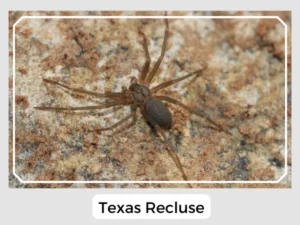The recluse spider is a special kind from the Sicariidae family. Guess where it lives? In places like Texas in the United States and also in Mexico! Join us as we share interesting facts about this spider.

Photo Credit: Jason Penney
Each sac contains about 30 to 50 eggs which are mostly small and round.
After being hatched they remain in the web for some time before dispersing.
Their webs have an irregular pattern, woven with the intention of capturing prey.
Yes, Texas Recluse spiders have venom. They use it mostly to catch their food, but it can also be harmful to humans. Like other recluse species, this one too has a necrotic bite in which the skin as well as surrounding tissues of the affected area may be damaged resulting in an open sore known as the necrotic lesion, taking time to heal. However, facts about the toxicity of the venom are unknown.
Yes, Texas Recluse spiders can bite. If they feel trapped or scared, they might bite. It’s a good idea to be careful around them.
The Texas Recluse Spider plays a vital role in the ecological balance of its habitat. As a predator, it aids in controlling the population of insects such as crickets, moths, and flies. Its nocturnal and reclusive nature keeps it hidden during the day, emerging under the veil of darkness to hunt.
Natural Predators: Despite being a predator itself, the Texas Recluse Spider is not exempt from threats. Birds, larger spiders, and certain insect species are known to prey upon them, especially the vulnerable spiderlings.
Prey-Predator Dynamics: This spider’s reclusive and nocturnal behavior is a testament to its adaptation for survival, minimizing encounters with predators while maximizing its hunting efficiency. The venom it possesses is a crucial tool for subduing prey, ensuring a steady food supply.
Relationship with Humans: The interaction between humans and the Texas Recluse Spider is a delicate dance. While they prefer secluded and undisturbed areas, their presence in homes, specifically in dark corners or beneath stored clothing, can lead to unintended encounters. Educating oneself on their habitats and exercising caution can help mitigate the risk of bites, fostering a safer coexistence.
| Lifespan | Approximately 2 to 4 years |
| Distribution | Parts of the United States and Mexico |
| Habitat | Outdoor: Under stones, abandoned burrows of rodents, and other secluded or undisturbed areas; Indoor: Dark corners, inside trunks, beneath stored clothing |
| Diet | Crickets, moths, flies, cockroaches, and other spiders |
In conclusion, by understanding the Texas Recluse Spider’s role in nature, its behavior, and its interactions with humans, we gain insight into the delicate balance of our ecosystem and the importance of every creature within it.
The recluse spider is a special kind from the Sicariidae family. Guess where it lives? In places like Texas in the United States and also in Mexico! Join us as we share interesting facts about this spider.

Photo Credit: Jason Penney
Each sac contains about 30 to 50 eggs which are mostly small and round.
After being hatched they remain in the web for some time before dispersing.
Their webs have an irregular pattern, woven with the intention of capturing prey.
Yes, Texas Recluse spiders have venom. They use it mostly to catch their food, but it can also be harmful to humans. Like other recluse species, this one too has a necrotic bite in which the skin as well as surrounding tissues of the affected area may be damaged resulting in an open sore known as the necrotic lesion, taking time to heal. However, facts about the toxicity of the venom are unknown.
Yes, Texas Recluse spiders can bite. If they feel trapped or scared, they might bite. It’s a good idea to be careful around them.
The Texas Recluse Spider plays a vital role in the ecological balance of its habitat. As a predator, it aids in controlling the population of insects such as crickets, moths, and flies. Its nocturnal and reclusive nature keeps it hidden during the day, emerging under the veil of darkness to hunt.
Natural Predators: Despite being a predator itself, the Texas Recluse Spider is not exempt from threats. Birds, larger spiders, and certain insect species are known to prey upon them, especially the vulnerable spiderlings.
Prey-Predator Dynamics: This spider’s reclusive and nocturnal behavior is a testament to its adaptation for survival, minimizing encounters with predators while maximizing its hunting efficiency. The venom it possesses is a crucial tool for subduing prey, ensuring a steady food supply.
Relationship with Humans: The interaction between humans and the Texas Recluse Spider is a delicate dance. While they prefer secluded and undisturbed areas, their presence in homes, specifically in dark corners or beneath stored clothing, can lead to unintended encounters. Educating oneself on their habitats and exercising caution can help mitigate the risk of bites, fostering a safer coexistence.
| Lifespan | Approximately 2 to 4 years |
| Distribution | Parts of the United States and Mexico |
| Habitat | Outdoor: Under stones, abandoned burrows of rodents, and other secluded or undisturbed areas; Indoor: Dark corners, inside trunks, beneath stored clothing |
| Diet | Crickets, moths, flies, cockroaches, and other spiders |
In conclusion, by understanding the Texas Recluse Spider’s role in nature, its behavior, and its interactions with humans, we gain insight into the delicate balance of our ecosystem and the importance of every creature within it.